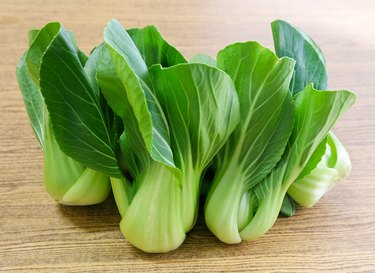
Bok choy, a variety of Chinese cabbage, is a versatile vegetable with stems that cook in the same amount of time as broccoli and leaves that cook in the same amount of time as spinach. You can buy small, tender heads of baby bok choy or substantial, hardier heads of the fully mature vegetable.
To cut baby bok choy, slice off the very tip of the white end and then cut the rest of the vegetable to a size that makes sense for your recipe. To cut mature bok choy, slice the heads in half lengthwise, cut the v-shaped core out of each half and then slice the remaining portion.
Video of the Day
Video of the Day
Pak Choi vs. Bok Choy
Pak choi and bok choy are actually two different names for the same vegetable, which is a Chinese cabbage with dark green leaves, white stems and various shades of green between the leaves and the stem. It is one of a family of Chinese cabbages, which include Napa cabbage, tatsoi and choy sum.
All of these cabbage varieties are members of the cruciferous, or brassica, vegetable family that also includes turnips, rutabagas, broccoli, cauliflower, mustard greens, kale, Brussels sprouts, collard greens and red and white head cabbages. Cruciferous vegetables are noteworthy for their health benefits, which include respectable levels of magnesium, calcium, potassium and vitamin K. They can also reportedly lower blood pressure and have anti-carcinogenic qualities.
Cutting and Prepping Bok Choy
Wash your bok choy thoroughly before cutting it because it may contain dirt, especially between the layers where it is hard to reach. You can separate the leaves to rinse them more thoroughly by cutting off the white stem end that holds them together. However, this may make it more difficult to cut your bok choy because the leaves will be separated and less manageable. Alternatively, you can cut your bok choy into bite-size pieces before cleaning between the leaves, transfer the pieces to a colander and then run water through them.
The stem end of a baby bok choy is tender enough that you don't really have to remove it. Trim as little as you can of the very bottom, the solid white part where the plant met the ground. The less you remove, the less food you'll waste. The bottom inch where the leaves come together will be dense, so you should cut it into smaller pieces than the rest of the cabbage to ensure even cooking.
Mature bok choy has a dense core, like a round head cabbage. While this core is technically edible, it's so much denser than the rest of the vegetable that it's best to remove it. Rather than slicing off the entire bottom few inches to remove that core, slice the cabbage in half lengthwise, cut out the v-shaped heart and then slice the rest of the bok choy into pieces of your desired size.
Baby vs. Mature Bok Choy
Baby bok choy is more tender than the mature alternative. Its smaller size also makes it a better choice if you're cooking for one because mature bok choy tends to be larger than would make sense for a single-serving recipe. In addition, if you're preparing a dish that contains a variety of vegetables, such as using bok choy in a stir fry, the smaller size of the baby variety leaves you plenty of room to add other vegetables such as peppers, leeks, carrots and asparagus.
If you're cooking for a crowd or preparing a recipe that uses bok choy as its primary vegetable, mature bok choy is the best option. You'll get plenty of food out of each head for relatively little work because you can cut more at once. Opt for convenience because the flavor is essentially the same.